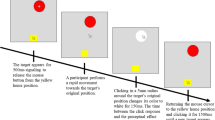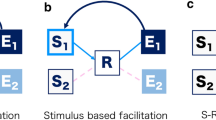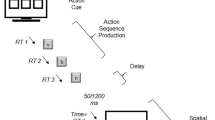Abstract
According to the ideomotor principle, behavior is controlled via a retrieval of the sensory consequences that will follow from the respective movement (“action-effects”). These consequences include not only what will happen, but also when something will happen. In fact, recollecting the temporal duration between response and effect takes time and prolongs the initiation of the response. We investigated the associative structure of action-effect learning with delayed effects and asked whether participants acquire integrated action-time-effect episodes that comprise a compound of all three elements or whether they acquire separate traces that connect actions to the time until an effect occurs and actions to the effects that follow them. In three experiments, results showed that participants retrieve temporal intervals that follow from their actions even when the identity of the effect could not be learned. Furthermore, retrieval of temporal intervals in isolation was not inferior to retrieval of temporal intervals that were consistently followed by predictable action-effects. More specifically, when tested under extinction, retrieval of action-time and action-identity associations seems to compete against each other, similar to overshadowing effects reported for stimulus–response conditioning. Together, these results suggest that people anticipate when the consequences of their action will occur, independently from what the consequences will be.

Similar content being viewed by others
Notes
Due to a programming error, instructions stated that in some trials a white asterisk would appear and participants would have to freely decide which key they wanted to press. However, these trials were never presented during the experiment.
Possibly, if participants in the fixed-effect mapping group had formed integrative A–T–E episodes, temporal information would only be retrieved for consistent responses (e.g. E > T>A), but not for inconsistent responses. However, an additional analysis for consistent response choices only showed no evidence for a delay-anticipation effect, |t| < 1.
A similar effect may have taken place in some studies where multiple action-effects provided contradictory information, for example, with the proprioceptive feedback occurring on the left side, whereas a visual action-effect occurred on the right side (e.g., Hommel, 1993; Janczyk, Pfister, Hommel, & Kunde, 2014). In such studies, one effect feature emerged as the main determinant of behavior and reduced/eliminated the impact of the other feature(s).
References
Ansorge, U. (2002). Spatial intention–response compatibility. Acta Psychologica, 109(3), 285–299.
Arantes, J., & Machado, A. (2008). Context effects in a temporal discrimination task: further tests of the scalar expectancy theory and learning-to-time models. Journal of the Experimental Analysis of Behavior, 90(1), 33–51.
Capizzi, M., Sanabria, D., & Correa, Á. (2012). Dissociating controlled from automatic processing in temporal preparation. Cognition, 123(2), 293–302.
Church, R. M., & Deluty, M. Z. (1977). Bisection of temporal intervals. Journal of Experimental Psychology: Animal Behavior Processes, 3(3), 216–228.
Correa, Á., Lupiáñez, J., Milliken, B., & Tudela, P. (2004). Endogenous temporal orienting of attention in detection and discrimination tasks. Perception and Psychophysics, 66(2), 264–278.
Coull, J. T., & Nobre, A. C. (1998). Where and when to pay attention: the neural systems for directing attention to spatial locations and to time intervals as revealed by both PET and fMRI. The Journal of Neuroscience, 18(18), 7426–7435.
Desantis, A., Hughes, G., & Waszak, F. (2012). Intentional binding is driven by the mere presence of an action and not by motor prediction. PLoS One, 7(1), e29557.
Dickinson, A. (2001). The 28th Bartlett memorial lecture causal learning: an associative analysis. The Quarterly Journal of Experimental Psychology: Section B, 54(1), 3–25.
Dignath, D., Pfister, R., Eder, A. B., Kiesel, A., & Kunde, W. (2014). Representing the hyphen in action–effect associations: automatic acquisition and bidirectional retrieval of action–effect intervals. Journal of Experimental Psychology. Learning, Memory, and Cognition, 40(6), 1701–1712.
Drew, M. R., Zupan, B., Cooke, A., Couvillon, P. A., & Balsam, P. D. (2005). Temporal control of conditioned responding in goldfish. Journal of Experimental Psychology: Animal Behavior Processes, 31(1), 31–39.
Elsner, B., & Hommel, B. (2001). Effect anticipation and action control. Journal of Experimental Psychology: Human Perception and Performance, 27(1), 229–240.
Elsner, B., & Hommel, B. (2004). Contiguity and contingency in action-effect learning. Psychological Research, 68(2–3), 138–154.
Flach, R., Osman, M., Dickinson, A., & Heyes, C. (2006). The interaction between response effects during the acquisition of response priming. Acta Psychologica, 122(1), 11–26.
Gallistel, C. R., & Gibbon, J. (2000). Time, rate, and conditioning. Psychological Review, 107(2), 289–344.
Haering, C., & Kiesel, A. (2012). Time in action contexts: learning when an action effect occurs. Psychological Research, 76(3), 336–344.
Haering, C., & Kiesel, A. (2014). Intentional Binding is independent of the validity of the action effect’s identity. Acta Psychologica, 152, 109–119.
Haggard, P., Clark, S., & Kalogeras, J. (2002). Voluntary action and conscious awareness. Nature Neuroscience, 5(4), 382–385.
Haggard, P., & Cole, J. (2007). Intention, attention and the temporal experience of action. Consciousness and Cognition, 16(2), 211–220.
Herbart, J. F. (1825). Psychologie als Wissenschaft neu gegründet auf Erfahrung, Metaphysik und Mathematik. Königsberg: August Wilhelm Unzer.
Herwig, A., Prinz, W., & Waszak, F. (2007). Two modes of sensorimotor integration in intention-based and stimulus-based actions. The Quarterly Journal of Experimental Psychology, 60(11), 1540–1554.
Hoffmann, J., Lenhard, A., Sebald, A., & Pfister, R. (2009). Movements or targets: what makes an action in action–effect learning? The Quarterly Journal of Experimental Psychology, 62(12), 2433–2449.
Hommel, B. (1993). Inverting the Simon effect by intention. Psychological Research, 55(4), 270–279.
Hommel, B. (2013). Ideomotor action control: on the perceptual grounding of voluntary actions and agents. In W. Prinz, M. Beisert, & A. Herwig (Eds.), Action science: Foundations of an emerging discipline (pp. 113–136). Cambridge: MIT Press.
Hommel, B., Müsseler, J., Aschersleben, G., & Prinz, W. (2001). The theory of event coding (TEC): a framework for perception and action planning. Behavioral and Brain Sciences, 24, 849–878.
Honig, W. K. (1981). Working memory and the temporal map. In N. E. Spear & R. R. Miller (Eds.), Information processing in animals: Memory mechanisms (pp. 167–197). Hillsdale: Erlbaum.
Hughes, G., Desantis, A., & Waszak, F. (2013). Mechanisms of intentional binding and sensory attenuation: the role of temporal prediction, temporal control, identity prediction, and motor prediction. Psychological Bulletin, 139(1), 133–151.
James, W. (1890/2011). The principles of psychology, vols. I, II. Cambridge: Harvard University Press.
Janczyk, M., Durst, M., & Ulrich, R. (2016). Action selection by temporally distal action-goals. Psychonomic Bulletin & Review (in press).
Janczyk, M., & Kunde, W. (2014). The role of effect grouping in free-choice response selection. Acta Psychologica, 150, 49–54.
Janczyk, M., Pfister, R., Hommel, B., & Kunde, W. (2014). Who is talking in backward crosstalk? Disentangling response- from goal-conflict in dual-task performance. Cognition, 132, 30–43.
Janczyk, M., Yamaguchi, M., Proctor, R. W., & Pfister, R. (2015). Response-effect compatibility with complex actions: the case of wheel rotations. Attention, Perception, and Psychophysics, 77(3), 930–940.
Jarosz, A. F., & Wiley, J. (2014). What are the odds? A practical guide to computing and reporting Bayes Factors. The Journal of Problem Solving, 7, 2–9.
Kamin, L. J. (1969). Predictability, surprise, attention and conditioning. In B. Campbell & R. Church (Eds.), Punishment and aversive behavior. New York: Appleton-Century-Crofts.
Kiesel, A., & Hoffmann, J. (2004). Variable action-effects: response control by context-specific effect anticipations. Psychological Research, 68(2–3), 155–162.
Koch, I., & Kunde, W. (2002). Verbal response-effect compatibility. Memory and Cognition, 30, 1297–1303.
Kunde, W. (2001). Response-effect compatibility in manual choice reaction tasks. Journal of Experimental Psychology: Human Perception and Performance, 27(2), 387–394.
Kunde, W. (2003). Temporal response-effect compatibility. Psychological Research, 67(3), 153–159.
Kunde, W., Pfister, R., & Janczyk, M. (2012). The locus of tool-transformation costs. Journal of Experimental Psychology: Human Perception and Performance, 38(3), 703.
Los, S. A., & Van Den Heuvel, C. E. (2001). Intentional and unintentional contributions to nonspecific preparation during reaction time foreperiods. Journal of Experimental Psychology: Human Perception and Performance, 27(2), 370–386.
Love, J., Selker, R., Verhagen, J., Marsman, M., Gronau, Q. F., Jamil, T., Smira, M., Epskamp, S., Wild, A., Morey, R., Rouder, J. & Wagenmakers, E. J. (2015). JASP (Version 0.7.5.6) [Computer software].
Mackintosh, N. J. (1976). Overshadowing and stimulus intensity. Animal Learning and Behavior, 4(2), 186–192.
Matzel, L. D., Held, F. P., & Miller, R. R. (1988). Information and expression of simultaneous and backward associations: implications for contiguity theory. Learning and Motivation, 19(4), 317–344.
Miller, R. R., & Barnet, R. C. (1993). The role of time in elementary associations. Current Directions in Psychological Science, 2(4), 106–111.
Miniussi, C., Wilding, E. L., Coull, J. T., & Nobre, A. C. (1999). Orienting attention in time. Brain, 122(8), 1507–1518.
Nattkemper, D., Ziessler, M., & Frensch, P. A. (2010). Binding in voluntary action control. Neuroscience and Biobehavioral Reviews, 34(7), 1092–1101.
Nobre, A. C. (2010). How can temporal expectations bias perception and action? In A. C. Nobre & J. T. Coull (Eds.), Attention and time (pp. 371–392). Oxford: Oxford University Press.
Paelecke, M., & Kunde, W. (2007). Action-effect codes in and before the central bottleneck: evidence from the psychological refractory period paradigm. Journal of Experimental Psychology: Human Perception and Performance, 33(3), 627–644.
Paulus, M. (2012). Action mirroring and action understanding: an ideomotor and attentional account. Psychological Research, 76(6), 760–767.
Pavlov, I. P. (1927). Conditioned reflexes. London: Oxford University Press.
Pearce, J. M., & Hall, G. (1980). A model for Pavlovian learning: variations in the effectiveness of conditioned but not of unconditioned stimuli. Psychological Review, 87(6), 532–552.
Pfister, R., & Janczyk, M. (2013). Confidence intervals for two sample means: calculation, interpretation, and a few simple rules. Advances in Cognitive Psychology, 9(2), 74–80.
Pfister, R., Kiesel, A., & Hoffmann, J. (2011). Learning at any rate: action-effect learning for stimulus-based actions. Psychological Research, 75(1), 61–65.
Rescorla, R. A. (1967). Pavlovian conditioning and its proper control procedures. Psychological Review, 74(1), 71–80.
Rescorla, R. A., & Wagner, A. R. (1972). A theory of Pavlovian conditioning: variations in the effectiveness of reinforcement and nonreinforcement. In A. H. Black & W. F. Prokasy (Eds.), Classical conditioning II: Current research and theory (pp. 64–99). New York: Appleton-Century-Crofts.
Rouder, J. N., Speckman, P. L., Sun, D., Morey, R. D., & Iverson, G. (2009). Bayesian t tests for accepting and rejecting the null hypothesis. Psychonomic Bulletin and Review, 16(2), 225–237.
Shin, Y. K., Proctor, R. W., & Capaldi, E. J. (2010). A review of contemporary ideomotor theory. Psychological Bulletin, 136(6), 943–974.
Takahata, K., Takahashi, H., Maeda, T., Umeda, S., Suhara, T., Mimura, M., & Kato, M. (2012). It’s not my fault: postdictive modulation of intentional binding by monetary gains and losses. PLoS One, 7(12), e53421.
Thomaschke, R., Wagener, A., Kiesel, A., & Hoffmann, J. (2011). The specificity of temporal expectancy: evidence from a variable foreperiod paradigm. The Quarterly Journal of Experimental Psychology, 64(12), 2289–2300.
Watson, P., van Steenbergen, H., de Wit, S., Wiers, R.W., & Hommel, B. (2015). Limits of ideomotor action-outcome acquisition. Brain Research, 1626, 45–53.
Wirth, R., Pfister, R., Janczyk, M., & Kunde, W. (2015). Through the portal: effect anticipation in the central bottleneck. Acta Psychologica, 160, 141–151.
Wolfensteller, U., & Ruge, H. (2011). On the timescale of stimulus-based action–effect learning. The Quarterly Journal of Experimental Psychology, 64(7), 1273–1289.
Yoshie, M., & Haggard, P. (2013). Negative emotional outcomes attenuate sense of agency over voluntary actions. Current Biology, 23(20), 2028–2032.
Acknowledgments
Data, analysis scripts, and program files for this article can be retrieved from the Open Science Framework: https://osf.io/vbg6w/?view_only=b0a38156b0754d438981d5b25ab2e4c4. Work of MJ is supported by the Institutional Strategy of the University of Tübingen (Deutsche Forschungsgemeinschaft (German Research Foundation), ZUK 63).
Author information
Authors and Affiliations
Corresponding author
Rights and permissions
About this article
Cite this article
Dignath, D., Janczyk, M. Anticipation of delayed action-effects: learning when an effect occurs, without knowing what this effect will be. Psychological Research 81, 1072–1083 (2017). https://doi.org/10.1007/s00426-016-0797-7
Received:
Accepted:
Published:
Issue Date:
DOI: https://doi.org/10.1007/s00426-016-0797-7




